A
Auto Express
Guest
Choose the best large panel van, and you'll be getting one of the most versatile vehicles for sale in the UK. With big payloads and even greater cargo volume, if you buy a large panel van, there won't be much that you can't carry. Even better, the latest big vans also now come with the latest technology, with kit you'd usually find in cars, extra tech designed for operators to get the most out of their fleets, as well as improved efficiency, including zero-emissions electric drive.
If you're buying a large panel van, you'll have plenty of choice in terms of body style. Most big vans are offered in three lengths and up to three roof heights. There are single and twin-wheel rear axle versions for carrying the biggest payloads, while 4x4 versions with raised ride height are available for specialist needs and more rugged work. But that's not all, because most large panel vans form the basis of a vast number of conversions. Some conversions are available directly from the factory, but there are also plenty of approved companies willing to build you a vehicle to your exact requirements.
• Best pickup trucks
You'll find crew van, crew cab, tipper and pick-up variants available, while multi-seat minibus versions cater for the private hire market. Conversions include adding racking and other useful features - while the latest large vans are prepped for being kitted out with this kit from the factory.
Choosing a chassis cab means you have the world of conversions at your feet. Want a Luton box body with tail-lift? All yours. How about an access platform on a hydraulic lift? Yep. And of course there are big motorhome conversions available that offer all the mod cons you could desire.

A large van is still a van with purpose, so unlike some mid-sized models they're still pretty van-like to drive, but they do now come with technology that only used to be seen on cars. Lane departure, adaptive cruise control, blind spot warning and rear traffic alert all help with manoeuvring these big machines, complementing standard kit such as large wing mirrors with wide-angle glass, and of course the high driving position that these vans offer.
Diesel power is the order of the day, because these engines offer the best mix of economy and pulling power. However, electric drive is on the rise, with a number of makers offering EVs for companies that deliver in emissions control areas. These vans have enough range to do a days' work, while the all-important cargo volume is unaffected, even if payload is.
It's also worth noting that the biggest large diesel vans don't necessarily have the largest payloads. These models need to have a gross weight that doesn't exceed 3.5 tonnes, otherwise they're no longer classed as light commercial vehicles, and you can't drive them on a standard car licence. If payload rather than cargo volume is important to you, it could be worthwhile looking at a slightly smaller van so you don't break the limit.
Check out our list below to see our favourite big vans, and then click through for the full Auto Express review of each of the models listed...
Best large panel vans 2020
1. Mercedes Sprinter
The Sprinter is our favourite large van. Why? Because it offers all of the payload, cargo volume and configurations you could possibly need from a large van, while it also offers the latest tech from the Mercedes car range.
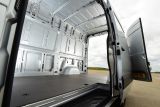
The Sprinter was the second model from Mercedes to receive the MBUX infotainment system (after the A-Class), while the van's connectivity means it's easy for fleet operators to monitor and track their vehicles via dedicated software. Throw in the latest safety kit and highlights such as blind spot monitoring, adaptive cruise control and lane keeping, and the Sprinter is a safe place to be. Go for a high-spec version, and it's plush, too.
As before there are a variety of lengths and roof heights on offer, and this Sprinter is the first one to be offered with a more efficient front-wheel drive layout. Diesel power is offered now, while the eSprinter will offer electric drive for urban delivery firms, and Mercedes has even revealed a hydrogen-powered campervan version as a vision of the future.
2. Volkswagen Crafter
The VW Crafter takes the formula of the mid-sized T6 Transporter and super-sizes it. There's the same level of quality inside, and like the Transporter it uses the same tech you'll find in the VW passenger car range. That means adaptive cruise control and lane assist are on offer, while self-parking including trailer assist is also available.

The Crafter is surprisingly car-like to drive, too. It feels nimble and handles well for such a large van, while still offering the high driving position and clear view of the road ahead that these machines are known for. You can even specify a truck-style sprung seat for greater long-distance comfort.
Like the Sprinter, there are diesel engines offered to make light work of the heaviest payloads, while different van lengths and roof heights are offered. There are Crew Cab pickup and tipper variants, too, while the Crafter-based VW Grand California is the biggest off-the-shelf motorhome you can buy.
Soon you'll also be able to get a zero-emissions VW e-Crafter for doing local deliveries, with a range of 60 miles easily achievable from a full charge.
3. MAN TGE
If the MAN TGE looks familiar, it should, because aside from the MAN badges, it's essentially the VW Crafter. You see, MAN is part of the VW Group, and while the maker is famous for its trucks, it has added the TGE to the line-up to cater for fleet truck users who need something a little smaller to bolster their fleet.
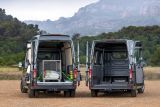
To say that the TGE is the smallest model in the MAN range seems crazy when the Crafter is the largest one in the VW Commercial Vehicles range. But when your fleet comprises 18 and 44-tonne lorries, then that's what it is. Either way, it benefits from the same range of tech as the Crafter, and there are the same variety of van sizes on offer, as well as Crew Cab Pickup and Chassis Cab versions so you can tailor your own bodywork to your needs.
The Crafter's safety kit is carried over intact, too. That means hands-free trailer parking assist is available, as well as adaptive cruise control, lane keeping with steering assist and blind spot detection, while crosswind assist is part of the stability control system.
4. Ford Transit
With the latest Transit, Ford divided up the range so that the largest model is called Transit, with the Transit Custom catering for the mid-sized sector. That has allowed Ford to concentrate on producing a large van that's perfect for work use, while constant updates have helped to keep the Transit fresh.
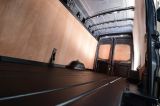
The most recent updates saw the Transit benefit from Ford's car tech, with the introduction of SYNC3 voice-controlled touchscreen sat-nav on top-spec versions. There was also the addition of a new EcoBlue diesel designed to improve efficiency over the older TDCi diesel. That means you'll go further on a tankful of diesel, without compromising on payload.
As before, there are panel van, crew cab and tipper versions of the Transit, while the passenger carrying versions are great for minibus work. And if you have a specific need in mind from your Transit, then the chassis cab version is available for conversion companies to do their work on.
5. Renault Master/Nissan NV400
The Renault Master is a veritable Swiss Army knife in the large van market. With 4 wheelbase lengths and 3 roof heights, there's sure to be a panel van to suit your needs, while the Crew Van version offers seating for up to 7 inside.
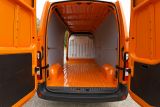
If that's not quite what you're after, there are off-the-shelf conversions, including Loloader, Luton, box van, tipper (including a lightweight aluminium version) and dropside variants, while going for the chassis cab opens up a variety of dedicated conversions from accredited suppliers.
Throw in the option of front or rear-wheel drive, and the Master really does cater for nearly every requirement. That includes electrification, with the Master ZE offering zero emissions driving for urban deliveries.
The most recent update to the Master introduced more car-like touches, and as ever it's a decent place to sit, with that tall driving position delivering a great view out. All of these attributes are shared with the Nissan NV400, which is essentially the same van (bar the electric option), with a 5-year warranty where the Master's is 3 years. Both have a 100,000-mile limit, though.
6. Vauxhall Movano
While the rest of the Vauxhall van range turns to the PSA Group for its source material with the new Combo and Vivaro models, the Movano carries on in its Renault Master-based guise. However, an update in 2019 saw the Movano get improved tech to help keep it competitive, much like the Master with which it shares so much.

Go for a top-spec Movano, and you can benefit from Vauxhall's Intellilink touchscreen infotainment system, while the latest connectivity means fleet operators can monitor vehicles and manage vehicles live.
There are the usual range of lengths, heights and wheelbases on offer, so there should be a Movano panel van to suit your load carrying needs, although do beware that the largest versions won't have the biggest payload.
Conversions include tipper, Luton and passenger carrying variants, while diesel power across the range helps to keep fuel costs in check.
7. Citroen Relay/Peugeot Boxer
Like the Renault Master and Nissan NV400, the Citroen Relay and Peugeot Boxer are essentially the same van, but with different badges on the nose. And like its Renault/Nissan counterpart, there's plenty of variety in the range, too.

There are four lengths in three wheelbases and three roof heights on offer, which means cargo volumes range from 8-17 cubic metres, while a payload of up to 1.44 tonnes is available if that's what's important to you.
Like rivals, there are off-the-shelf conversions also offered, with Luton, dropside, tipper, box body and even curtainside versions available direct from dealers. And like rivals, Citroen and Peugeot offer electric versions of the Relay and Boxer.
In the cab, it's pretty basic when compared to the very latest large vans, but it's functional and roomy for three across the cab.
Power comes from BlueHDi diesels ranging from 110 to 160 power outputs, and while they're a bit noisy, they get the job done.
8. Fiat Ducato
If the Fiat Ducato looks familiar, that's because it shares a lot of its tech and construction with the Citroen Relay/Peugeot Boxer duo. The big difference, though, is that Fiat uses its own engines.

That means you have a choice of 2.0 115 Multijet or 2.2 Multijet in 130, 150 or 180 guises. Not only that, but the 150 version also comes in Ecojet guise with additional fuel saving tech included. There's even an electric conversion available, should you need one.
One thing that doesn't change over the PSA models is the cargo volumes that the Ducato can carry. There's a maximum cargo volume of up to 17 cubic metres, while payloads are available up to 2.2 tonnes.
As well as the panel van, there's a spacious crew van variant and a dropside or tipper, which comes in either single or double cab forms. Whichever version you choose, the Fiat can be had with a traction control system that can compensate for off-road driving, while the stability control automatically adjusts according to the amount of payload and its distribution in the load area.
9. Iveco Daily
Another large van from a maker more familiar to the truck fraternity, the Iveco Daily is the smallest vehicle that the truck maker builds. And it was given an update in 2019 to make it more efficient without compromising payload weights or volumes.
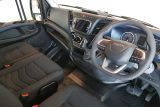
There's improved safety tech, too, with emergency city braking, adaptive cruise, crosswind control, hill descent and lane assist all making an appearance. These systems are possible due to the addition of electric power steering, which also makes manoeuvring the Daily a breeze on city streets.
The Daily comes with a choice of engines, with the light-duty versions featuring a 2.3-litre diesel, and the heavy-duty vans coming with a 3.0-litre diesel with up to 210bhp. That latter engine is offered in vans that exceed the 3.5-tonne LCV weight limit, so you'll need a CV licence to drive one.
2019's update saw the Daily get a subtly revised look, too, but it's one that's designed to deliver greater efficiency over a radical revamp. The changes under the skin are more significant, and with the addition of the latest connected services, it's a good choice for fleet operators.
10. Maxus (LDV) V80
The Maxus V80 has one thing on its side - the sheer value for money that it offers. No other van can deliver as much space for the price, because while it's the size of a large van, the price tag is in line with the small van sector.

If the V80 looks familiar - and we're not just talking about the passing resemblance to the previous generation Ford Transit - that's because it's essentially the LDV Maxus that went out of production in 2009. When LDV went out of business, the assets were bought by Chinese firm SAIC, which launched its own version of the Maxus in China in 2011.
With its return to the UK, the V80 offers cut-price load carrying, but it's clear that you get what you pay for. While the load area ranges from 6.9-11.4 cubic metres whether you choose Low Roof SWB, Medium Roof LWB or High Roof LWB versions, the cab is where the van really shows its age: The design is similar to the Maxus that went off sale over a decade ago.
Under the bonnet is a VM Motori diesel with around 138bhp on offer. It's a noisy unit that uses a clunky manual gearbox. If you're doing short runs, then the all-electric EV80 might be a better bet. This is a lot smoother thanks to its quiet electric motor and direct drive, while a claimed range of 120 miles is good for a day's work. Even better is the fact that both diesel and EV versions come in panel van, chassis cab and minibus versions, all at knock-down prices, but with a five-year warranty.
Read more of our best car and van recommendations...
For a list of the best high roof vans on sale, take a look at our sister site Buyacar...
Continue reading...
If you're buying a large panel van, you'll have plenty of choice in terms of body style. Most big vans are offered in three lengths and up to three roof heights. There are single and twin-wheel rear axle versions for carrying the biggest payloads, while 4x4 versions with raised ride height are available for specialist needs and more rugged work. But that's not all, because most large panel vans form the basis of a vast number of conversions. Some conversions are available directly from the factory, but there are also plenty of approved companies willing to build you a vehicle to your exact requirements.
• Best pickup trucks
You'll find crew van, crew cab, tipper and pick-up variants available, while multi-seat minibus versions cater for the private hire market. Conversions include adding racking and other useful features - while the latest large vans are prepped for being kitted out with this kit from the factory.
Choosing a chassis cab means you have the world of conversions at your feet. Want a Luton box body with tail-lift? All yours. How about an access platform on a hydraulic lift? Yep. And of course there are big motorhome conversions available that offer all the mod cons you could desire.

A large van is still a van with purpose, so unlike some mid-sized models they're still pretty van-like to drive, but they do now come with technology that only used to be seen on cars. Lane departure, adaptive cruise control, blind spot warning and rear traffic alert all help with manoeuvring these big machines, complementing standard kit such as large wing mirrors with wide-angle glass, and of course the high driving position that these vans offer.
Diesel power is the order of the day, because these engines offer the best mix of economy and pulling power. However, electric drive is on the rise, with a number of makers offering EVs for companies that deliver in emissions control areas. These vans have enough range to do a days' work, while the all-important cargo volume is unaffected, even if payload is.
It's also worth noting that the biggest large diesel vans don't necessarily have the largest payloads. These models need to have a gross weight that doesn't exceed 3.5 tonnes, otherwise they're no longer classed as light commercial vehicles, and you can't drive them on a standard car licence. If payload rather than cargo volume is important to you, it could be worthwhile looking at a slightly smaller van so you don't break the limit.
Check out our list below to see our favourite big vans, and then click through for the full Auto Express review of each of the models listed...
Best large panel vans 2020
1. Mercedes Sprinter
The Sprinter is our favourite large van. Why? Because it offers all of the payload, cargo volume and configurations you could possibly need from a large van, while it also offers the latest tech from the Mercedes car range.

The Sprinter was the second model from Mercedes to receive the MBUX infotainment system (after the A-Class), while the van's connectivity means it's easy for fleet operators to monitor and track their vehicles via dedicated software. Throw in the latest safety kit and highlights such as blind spot monitoring, adaptive cruise control and lane keeping, and the Sprinter is a safe place to be. Go for a high-spec version, and it's plush, too.
As before there are a variety of lengths and roof heights on offer, and this Sprinter is the first one to be offered with a more efficient front-wheel drive layout. Diesel power is offered now, while the eSprinter will offer electric drive for urban delivery firms, and Mercedes has even revealed a hydrogen-powered campervan version as a vision of the future.
2. Volkswagen Crafter
The VW Crafter takes the formula of the mid-sized T6 Transporter and super-sizes it. There's the same level of quality inside, and like the Transporter it uses the same tech you'll find in the VW passenger car range. That means adaptive cruise control and lane assist are on offer, while self-parking including trailer assist is also available.

The Crafter is surprisingly car-like to drive, too. It feels nimble and handles well for such a large van, while still offering the high driving position and clear view of the road ahead that these machines are known for. You can even specify a truck-style sprung seat for greater long-distance comfort.
Like the Sprinter, there are diesel engines offered to make light work of the heaviest payloads, while different van lengths and roof heights are offered. There are Crew Cab pickup and tipper variants, too, while the Crafter-based VW Grand California is the biggest off-the-shelf motorhome you can buy.
Soon you'll also be able to get a zero-emissions VW e-Crafter for doing local deliveries, with a range of 60 miles easily achievable from a full charge.
3. MAN TGE
If the MAN TGE looks familiar, it should, because aside from the MAN badges, it's essentially the VW Crafter. You see, MAN is part of the VW Group, and while the maker is famous for its trucks, it has added the TGE to the line-up to cater for fleet truck users who need something a little smaller to bolster their fleet.

To say that the TGE is the smallest model in the MAN range seems crazy when the Crafter is the largest one in the VW Commercial Vehicles range. But when your fleet comprises 18 and 44-tonne lorries, then that's what it is. Either way, it benefits from the same range of tech as the Crafter, and there are the same variety of van sizes on offer, as well as Crew Cab Pickup and Chassis Cab versions so you can tailor your own bodywork to your needs.
The Crafter's safety kit is carried over intact, too. That means hands-free trailer parking assist is available, as well as adaptive cruise control, lane keeping with steering assist and blind spot detection, while crosswind assist is part of the stability control system.
4. Ford Transit
With the latest Transit, Ford divided up the range so that the largest model is called Transit, with the Transit Custom catering for the mid-sized sector. That has allowed Ford to concentrate on producing a large van that's perfect for work use, while constant updates have helped to keep the Transit fresh.

The most recent updates saw the Transit benefit from Ford's car tech, with the introduction of SYNC3 voice-controlled touchscreen sat-nav on top-spec versions. There was also the addition of a new EcoBlue diesel designed to improve efficiency over the older TDCi diesel. That means you'll go further on a tankful of diesel, without compromising on payload.
As before, there are panel van, crew cab and tipper versions of the Transit, while the passenger carrying versions are great for minibus work. And if you have a specific need in mind from your Transit, then the chassis cab version is available for conversion companies to do their work on.
5. Renault Master/Nissan NV400
The Renault Master is a veritable Swiss Army knife in the large van market. With 4 wheelbase lengths and 3 roof heights, there's sure to be a panel van to suit your needs, while the Crew Van version offers seating for up to 7 inside.

If that's not quite what you're after, there are off-the-shelf conversions, including Loloader, Luton, box van, tipper (including a lightweight aluminium version) and dropside variants, while going for the chassis cab opens up a variety of dedicated conversions from accredited suppliers.
Throw in the option of front or rear-wheel drive, and the Master really does cater for nearly every requirement. That includes electrification, with the Master ZE offering zero emissions driving for urban deliveries.
The most recent update to the Master introduced more car-like touches, and as ever it's a decent place to sit, with that tall driving position delivering a great view out. All of these attributes are shared with the Nissan NV400, which is essentially the same van (bar the electric option), with a 5-year warranty where the Master's is 3 years. Both have a 100,000-mile limit, though.
6. Vauxhall Movano
While the rest of the Vauxhall van range turns to the PSA Group for its source material with the new Combo and Vivaro models, the Movano carries on in its Renault Master-based guise. However, an update in 2019 saw the Movano get improved tech to help keep it competitive, much like the Master with which it shares so much.

Go for a top-spec Movano, and you can benefit from Vauxhall's Intellilink touchscreen infotainment system, while the latest connectivity means fleet operators can monitor vehicles and manage vehicles live.
There are the usual range of lengths, heights and wheelbases on offer, so there should be a Movano panel van to suit your load carrying needs, although do beware that the largest versions won't have the biggest payload.
Conversions include tipper, Luton and passenger carrying variants, while diesel power across the range helps to keep fuel costs in check.
7. Citroen Relay/Peugeot Boxer
Like the Renault Master and Nissan NV400, the Citroen Relay and Peugeot Boxer are essentially the same van, but with different badges on the nose. And like its Renault/Nissan counterpart, there's plenty of variety in the range, too.

There are four lengths in three wheelbases and three roof heights on offer, which means cargo volumes range from 8-17 cubic metres, while a payload of up to 1.44 tonnes is available if that's what's important to you.
Like rivals, there are off-the-shelf conversions also offered, with Luton, dropside, tipper, box body and even curtainside versions available direct from dealers. And like rivals, Citroen and Peugeot offer electric versions of the Relay and Boxer.
In the cab, it's pretty basic when compared to the very latest large vans, but it's functional and roomy for three across the cab.
Power comes from BlueHDi diesels ranging from 110 to 160 power outputs, and while they're a bit noisy, they get the job done.
8. Fiat Ducato
If the Fiat Ducato looks familiar, that's because it shares a lot of its tech and construction with the Citroen Relay/Peugeot Boxer duo. The big difference, though, is that Fiat uses its own engines.

That means you have a choice of 2.0 115 Multijet or 2.2 Multijet in 130, 150 or 180 guises. Not only that, but the 150 version also comes in Ecojet guise with additional fuel saving tech included. There's even an electric conversion available, should you need one.
One thing that doesn't change over the PSA models is the cargo volumes that the Ducato can carry. There's a maximum cargo volume of up to 17 cubic metres, while payloads are available up to 2.2 tonnes.
As well as the panel van, there's a spacious crew van variant and a dropside or tipper, which comes in either single or double cab forms. Whichever version you choose, the Fiat can be had with a traction control system that can compensate for off-road driving, while the stability control automatically adjusts according to the amount of payload and its distribution in the load area.
9. Iveco Daily
Another large van from a maker more familiar to the truck fraternity, the Iveco Daily is the smallest vehicle that the truck maker builds. And it was given an update in 2019 to make it more efficient without compromising payload weights or volumes.

There's improved safety tech, too, with emergency city braking, adaptive cruise, crosswind control, hill descent and lane assist all making an appearance. These systems are possible due to the addition of electric power steering, which also makes manoeuvring the Daily a breeze on city streets.
The Daily comes with a choice of engines, with the light-duty versions featuring a 2.3-litre diesel, and the heavy-duty vans coming with a 3.0-litre diesel with up to 210bhp. That latter engine is offered in vans that exceed the 3.5-tonne LCV weight limit, so you'll need a CV licence to drive one.
2019's update saw the Daily get a subtly revised look, too, but it's one that's designed to deliver greater efficiency over a radical revamp. The changes under the skin are more significant, and with the addition of the latest connected services, it's a good choice for fleet operators.
10. Maxus (LDV) V80
The Maxus V80 has one thing on its side - the sheer value for money that it offers. No other van can deliver as much space for the price, because while it's the size of a large van, the price tag is in line with the small van sector.

If the V80 looks familiar - and we're not just talking about the passing resemblance to the previous generation Ford Transit - that's because it's essentially the LDV Maxus that went out of production in 2009. When LDV went out of business, the assets were bought by Chinese firm SAIC, which launched its own version of the Maxus in China in 2011.
With its return to the UK, the V80 offers cut-price load carrying, but it's clear that you get what you pay for. While the load area ranges from 6.9-11.4 cubic metres whether you choose Low Roof SWB, Medium Roof LWB or High Roof LWB versions, the cab is where the van really shows its age: The design is similar to the Maxus that went off sale over a decade ago.
Under the bonnet is a VM Motori diesel with around 138bhp on offer. It's a noisy unit that uses a clunky manual gearbox. If you're doing short runs, then the all-electric EV80 might be a better bet. This is a lot smoother thanks to its quiet electric motor and direct drive, while a claimed range of 120 miles is good for a day's work. Even better is the fact that both diesel and EV versions come in panel van, chassis cab and minibus versions, all at knock-down prices, but with a five-year warranty.
Read more of our best car and van recommendations...
| Best small vans | Best panel vans |
| Best pick-ups | Best medium vans |
| Best company cars | Best 8-seaters |
| Best van deals | Best Motability cars |
For a list of the best high roof vans on sale, take a look at our sister site Buyacar...
Continue reading...
